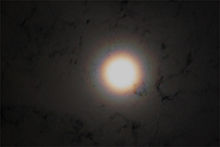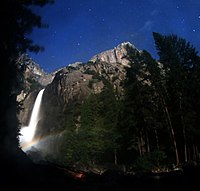Hi Everybody!!
Wow O Wow- What a sight to see this Moon Rainbow last night!. I never saw one before. Of course, I went to the Google Index Search to find out if they were there. Ah-ha- This is called a Moonbow (excerpt from Wikipedia below). I see from the definition that what I have is a false moonbow, actually, it is called a Corona (definition below).
Whatever; it was fantastic to behold!
Your photostudy tonight is this special optical phenomenon so You can see it, also. Enjoy!
P.S.: You may wonder what I was doing out on the front deck at 2:45 a.m. with a camera. I was trying to get a snap of the armadillo, but he got away. (I will get him!)
http://en.wikipedia.org/wiki/Moonbow
Moonbow
From Wikipedia, the free encyclopedia
A moonbow (also known as a lunar rainbow, black rainbow, white rainbow, lunar bow, or space rainbow) is a rainbow produced by light reflected off the surface of the moon (rather than from direct sunlight) refracting off of moisture in the air. Moonbows are relatively faint, due to the smaller amount of light reflected from the surface of the moon. They are always in the opposite part of the sky from the moon.
Because the light is usually too faint to excite the cone color receptors in human eyes, it is difficult for the human eye to discern colors in a moonbow. As a result, they often appear to be white.[1] However, the colors in a moonbow do appear in long exposure photographs.
True moonbows[edit|edit source]
A true moonbow is lit by reflected light from the Moon, not directly by the Sun. In contrast, a colored rainbow (or a white fogbow) seen when the sun is rising or setting, or in twilight, is not a moonbow because it is still produced by sunlight.
Moonbows have been mentioned at least since Aristotle's Meteorology (circa 350 BC), and also in an 1847 publication.[2]
False moonbows[edit]
A colored circle around the moon is not a moonbow—it is usually a 22° halo produced by refraction through hexagonal ice crystals in cirrus cloud. Colored rings close to the moon are a corona, a diffraction phenomenon produced by minuscule water droplets or ice crystals in clouds.
Moonbow viewing[edit]
Moonbows are most easily viewed when the moon is near to full (when it is brightest). For true moonbows, other than those produced by waterfalls or sprays, the moon must be low in the sky (less than 42 degrees and preferably lower) and the sky must be very dark. Since the sky is still light on a rising full moon, this means they can only be observed 2 to 3 hours before sunrise, a time with few observers. And, of course, there must be rain falling opposite the moon. This combination of requirements makes moonbows much rarer than rainbows produced by the sun. Moonbows may also be visible when rain falls during full moonrise at extreme latitudes during the winter months, when the prevalence of the hours of darkness give more opportunity for the phenomenon to be observed.
Notable spray moonbow locations[edit|edit source]
Few places in the world frequently feature spray moonbows. Such sites in the United States include several waterfalls in Yosemite National Park, California[3] and Cumberland Falls, near Corbin, Kentucky.[4][5] Victoria Falls, in Africa on the border between Zambiaand Zimbabwe, is also widely known for spray moonbows.[6][7] Moonbows have also been spotted at Waimea on the Big Island of Hawaii.[8]
http://en.wikipedia.org/wiki/Corona_(meteorology)
Corona (optical phenomenon)
From Wikipedia, the free encyclopedia
(Redirected from Corona (meteorology))
In meteorology, a corona is produced by the diffraction of light from either the Sun or the Moon by individual small water droplets (and sometimes tiny ice crystals) of a cloud or on a foggy glass surface.
The corona consists of small number of concentric colored rings around the celestial object and a central bright aureole. The angular size of the corona depends on the diameters of the cloud droplets - small droplets produce large coronae. For the same reason, the corona is clearest when the size of the droplets is most uniform. Coronae differ from haloes in that the latter are formed by refraction (rather than diffraction) from comparatively large rather than small ice crystals. Reddish colors always occupy the outer part of a corona's ring. (This is an atmospheric Airy disc.)
See also[edit|edit source]

Welcome To My New Feeding Station for the birds. This is a fenced in area to keep the bad cats out. So far, so good. It is also the only place on the grounds where I can see the sky!
I would like to encourage You to set up a station where You are.
...this is brendasue signing off from Rainbow Creek. See You next time!
Feed some Birds! Have Fun!
O+O






































No comments:
Post a Comment
Hi Everybody! Please say hello and follow so I know you are here! Due to the inconsideration of people trying to put commercials on my blog comment area, I have restricted use of anonymous posts. Sorry that some hurt all.
My public email is katescabin@gmail.com No spammers or trolls